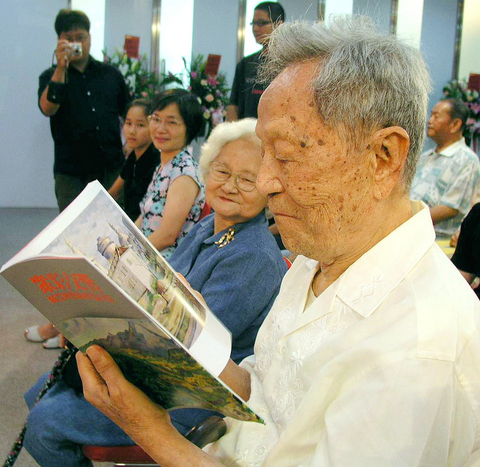To commemorate artist Chen Hui-kun's (
The book-launching ceremony was held by Egret Cultural & Educational Foundation (白鷺鷥文教基金會) and the Art & Collection Group (典藏藝術家庭) at the National Cultural Association (NCA) yesterday.
Chen, the father of NCA Secretary-General Tchen Yu-chiou (陳郁秀), was born on June 25th, 1907 in Taichung and had a difficult childhood after his parents' death.

PHOTO: LING MEI-HSUEH, TAIPEI TIMES
In primary school, his mentor learned that he was keenly interested in clay sculpture, and told him a story about Huang Tu-shui (黃土水), the first Taiwanese sculptor to study abroad in Japan. This inspired him to study in Japan.
The idea to study abroad was further strengthened during his high school days at National Taichung First Senior High School, when he happened to find three art magazines from France and a brochure from Tokyo Art School (renamed Tokyo National University of Fine Arts and Music in 1949).
In 1927, he made his dream come true by learning to sketch in Japan.
In 1948, he began his life as a professor at National Taiwan Normal University. In 1960, Chen went to Paris to continue his education although he was already 54 years old at the time. Though he is blind in one eye and is hard of hearing, he kept painting until recently.
Chen's work successfully combines the characteristics of Western, Chinese and Japanese art. His style reflects and interacts with the diversified characteristics of Taiwanese art.
"I always see my father's passion and persistence in art," Chen Yu-shiu (
She also thanked those professors and artists who contributed essays on her father's work for the new released book and enabled her to know her father's accomplishments better.
"The intricacies of oil paintings, Chinese ink paintings, poems and calligraphy were absorbed and mastered amazingly by Chen. He is really a grand artist in Taiwan's interwoven history of immigration and colonization," said Ni Tsai-chin (

SHIPS, TRAINS AND AUTOMOBILES: The ministry has announced changes to varied transportation industries taking effect soon, with a number of effects for passengers Beginning next month, the post office is canceling signature upon delivery and written inquiry services for international registered small packets in accordance with the new policy of the Universal Postal Union, the Ministry of Transportation and Communications said yesterday. The new policy does not apply to packets that are to be delivered to China, the ministry said. Senders of international registered small packets would receive a NT$10 rebate on postage if the packets are sent from Jan. 1 to March 31, it added. The ministry said that three other policies are also scheduled to take effect next month. International cruise ship operators

NUMBERS IMBALANCE: More than 4 million Taiwanese have visited China this year, while only about half a million Chinese have visited here Beijing has yet to respond to Taiwan’s requests for negotiation over matters related to the recovery of cross-strait tourism, the Tourism Administration said yesterday. Taiwan’s tourism authority issued the statement after Chinese-language daily the China Times reported yesterday that the government’s policy of banning group tours to China does not stop Taiwanese from visiting the country. As of October, more than 4.2 million had traveled to China this year, exceeding last year. Beijing estimated the number of Taiwanese tourists in China could reach 4.5 million this year. By contrast, only 500,000 Chinese tourists are expected in Taiwan, the report said. The report

Temperatures are forecast to drop steadily as a continental cold air mass moves across Taiwan, with some areas also likely to see heavy rainfall, the Central Weather Administration (CWA) said. From today through early tomorrow, a cold air mass would keep temperatures low across central and northern Taiwan, and the eastern half of Taiwan proper, with isolated brief showers forecast along Keelung’s north coast, Taipei and New Taipei City’s mountainous areas and eastern Taiwan, it said. Lows of 11°C to 15°C are forecast in central and northern Taiwan, Yilan County, and the outlying Kinmen and Lienchiang (Matsu) counties, and 14°C to 17°C

STEERING FAILURE: The first boat of its class is experiencing teething issues as it readies for acceptance by the navy, according to a recent story about rudder failure The Hai Kun (海鯤), the nation’s first locally built submarine, allegedly suffered a total failure of stern hydraulic systems during the second round of sea acceptance trials on June 26, and sailors were forced to manually operate the X-rudder to turn the submarine and return to port, news Web site Mirror Daily reported yesterday. The report said that tugboats following the Hai Kun assisted the submarine in avoiding collisions with other ships due to the X-rudder malfunctioning. At the time of the report, the submarine had completed its trials and was scheduled to begin diving and surfacing tests in shallow areas. The X-rudder,